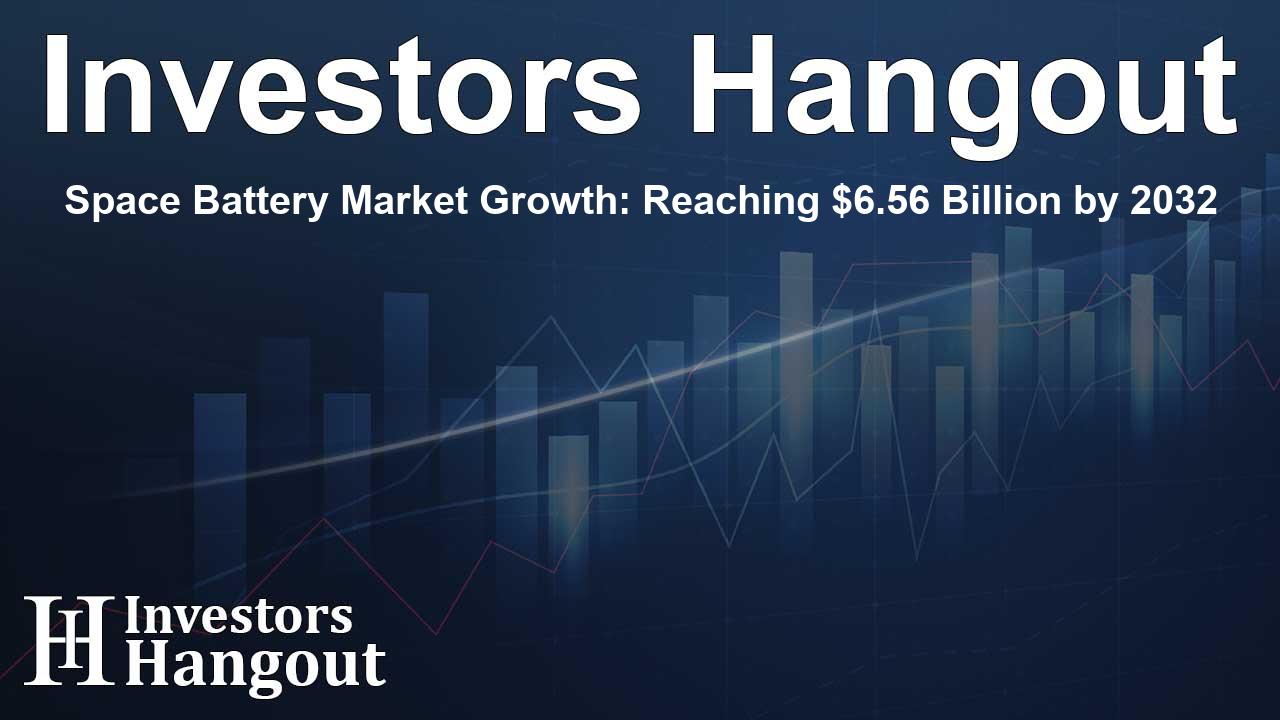Space Battery Market Growth: Reaching $6.56 Billion by 2032

Understanding the Expanding Space Battery Market
The space battery market is undergoing rapid growth, driven by the demand for more efficient energy solutions in space exploration. Improved lithium-ion batteries are at the forefront of this transformation, offering enhanced energy density, safety, and lightweight performance crucial for various space missions. Recent developments highlight the success of companies such as EaglePicher Technologies, which continue to innovate in defense and aerospace battery systems.
Market Expansion and Future Projections
According to recent findings from Introspective Market Research, the global space battery market, valued at USD 3.66 billion, is poised for substantial growth, reaching USD 6.56 billion by 2032. This significant advancement represents a strong compound annual growth rate (CAGR) of 6.70% from 2024 to 2032. The increasing number of satellite launches and ambitious space missions is a key catalyst for this growth, as governments and private companies prioritize exploring both the Moon and Mars.
The Role of Lithium-Ion Batteries
Lithium-ion (Li-ion) batteries have emerged as the preferred energy solution in the space sector due to their high energy density. These batteries allow for a greater energy reserve in a smaller, lighter package, making them ideal for space missions that necessitate strict weight controls. Additionally, advancements in safety and reliability have bolstered their adoption in critical space missions, where battery failures are unacceptable.
Driving Forces Behind Market Growth
A notable increase in satellite launches, especially for global communication systems and internet connectivity, has further propelled the space battery market. Companies like SpaceX are pushing the envelope for satellite deployment, creating a heightened demand for reliable and powerful battery systems. Alongside advancements in battery technologies, manufacturers are also focusing on improving thermal management and radiation resistance to ensure durability in the hostile environment of space.
Integration of IoT and Advanced 5G Services
The introduction of Internet of Things (IoT) devices combined with advanced 5G infrastructure marks a significant breakthrough for the space battery sector. These technologies facilitate real-time data collection and efficient monitoring of energy consumption and equipment functionality within space industry facilities. Utilizing IoT connections through 5G networks allows for instantaneous data transmission, enabling enhanced operational sustainability and cost efficiency.
Challenges in Battery Technology for Space
Despite its promising growth, the space battery market faces significant challenges. Batteries must endure harsh conditions, including extreme temperatures, vacuum of space, and radiation. These factors can impair battery performance and lifespan. Manufacturers are investing heavily in R&D, developing materials such as solid-state batteries that demonstrate resilience against the demanding environment of space travel, thus ensuring mission success.
Key Competitors Shaping the Market
The competitive landscape of the space battery market consists of several key players, each striving to innovate and capture market share. Companies such as GS Yuasa and Saft have announced exciting advancements in battery technology that cater specifically to the rigorous requirements of aerospace missions. Their focus is not only on battery composition improvements but also on creating protective measures against the detrimental effects of space.
Future Direction and Innovations
As the demand for sophisticated space exploration continues to rise, the importance of advanced batteries cannot be understated. The integration of emerging technologies, such as wireless power transmission and energy-harvesting systems, paves the way for sustainable and efficient energy solutions. With concepts like lunar bases and Mars colonies on the horizon, the need for small, long-lasting, and efficient space batteries has become more critical than ever.
Frequently Asked Questions
What factors contribute to the growth of the space battery market?
The growth is driven primarily by an increase in satellite launches and an uptick in space exploration missions by government and private entities.
Why are lithium-ion batteries favored in space applications?
Lithium-ion batteries are preferred due to their high energy density, lightweight design, and ongoing advancements in safety and reliability, making them ideal for space missions.
What challenges do space batteries face?
Space batteries contend with extreme temperatures, radiation exposure, and vacuum conditions which significantly impact efficiency and lifespan.
How does IoT impact the space battery sector?
IoT integration enhances monitoring capabilities and data analysis in real time, leading to better energy management in space facilities.
What innovative technologies are anticipated for future space missions?
Future innovations may include wireless power transmission and energy scavenging methods, creating more sustainable energy solutions for space exploration.
About Investors Hangout
Investors Hangout is a leading online stock forum for financial discussion and learning, offering a wide range of free tools and resources. It draws in traders of all levels, who exchange market knowledge, investigate trading tactics, and keep an eye on industry developments in real time. Featuring financial articles, stock message boards, quotes, charts, company profiles, and live news updates. Through cooperative learning and a wealth of informational resources, it helps users from novices creating their first portfolios to experts honing their techniques. Join Investors Hangout today: https://investorshangout.com/
Disclaimer: The content of this article is solely for general informational purposes only; it does not represent legal, financial, or investment advice. Investors Hangout does not offer financial advice; the author is not a licensed financial advisor. Consult a qualified advisor before making any financial or investment decisions based on this article. The author's interpretation of publicly available data shapes the opinions presented here; as a result, they should not be taken as advice to purchase, sell, or hold any securities mentioned or any other investments. The author does not guarantee the accuracy, completeness, or timeliness of any material, providing it "as is." Information and market conditions may change; past performance is not indicative of future outcomes. If any of the material offered here is inaccurate, please contact us for corrections.